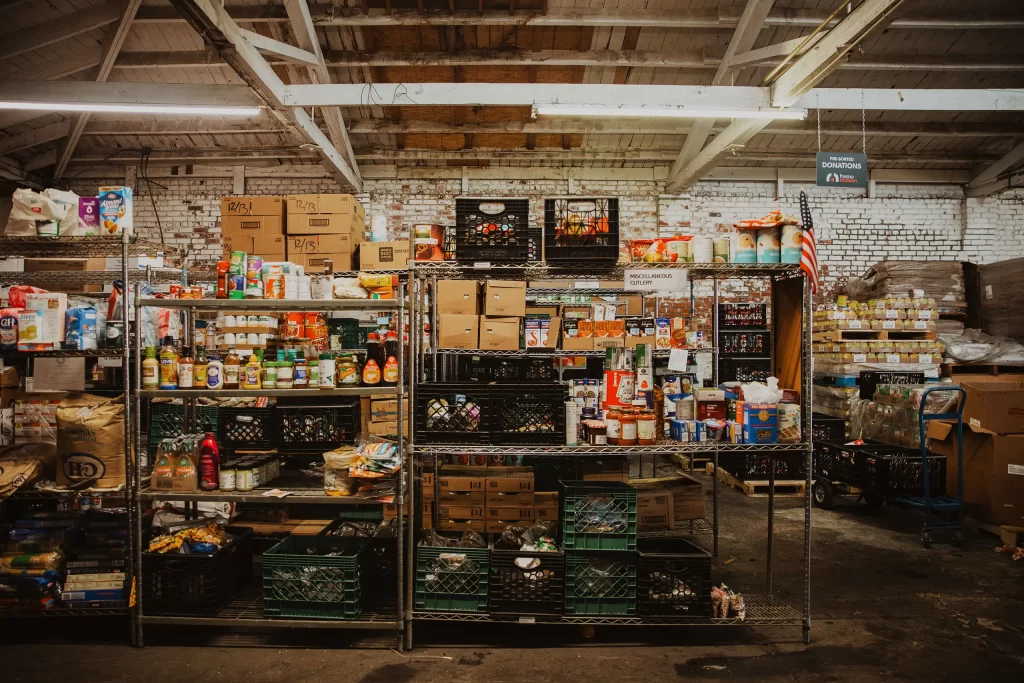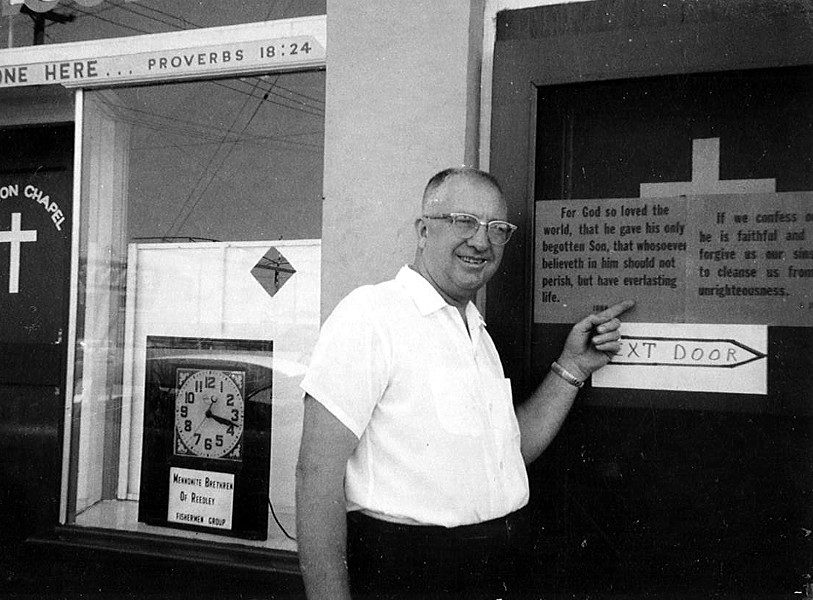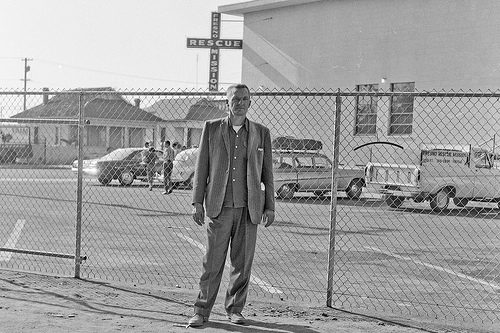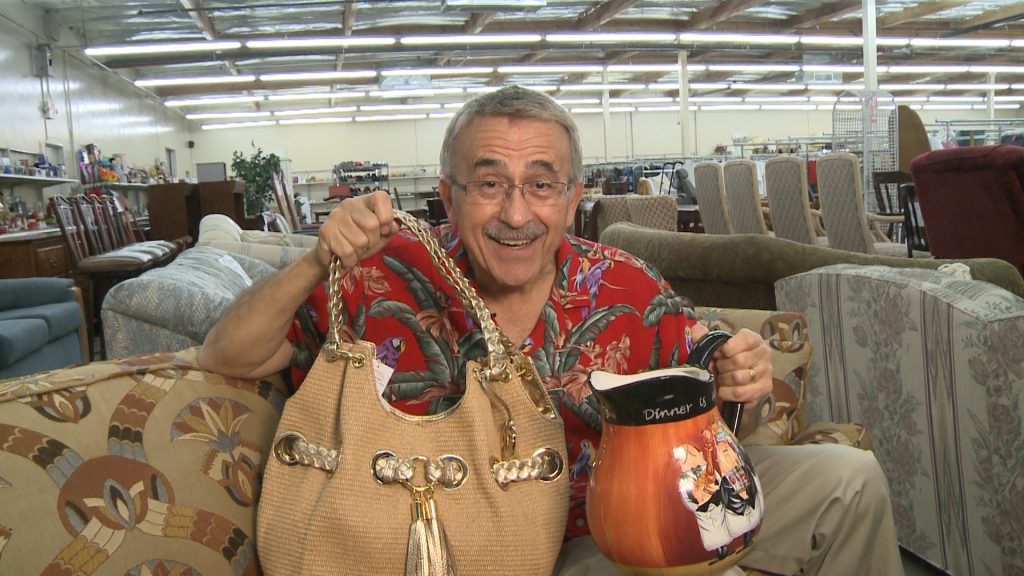
Our Story
The Fresno Mission was founded in 1949 as the Fresno Rescue Mission, a Christ-centered organization addressing the physical and spiritual needs of Fresno’s impoverished community. Established by Rev. Clifford Phillips and Dr. Dwight Trowbridge, the Mission began on skid row, serving alcoholics and transient workers, eventually evolving into a multifaceted organization providing shelter, recovery, and hope to homeless families, individuals battling addiction, and the incarcerated.
Introduction
1949–1963
1964–1968
1969–1982
1990–1999
2000–2005
2006–2008
2009–2011
2012–2013
2014–Present

Introduction
Cliff Phillips, an Indiana farm boy turned devoted Christian in his thirties, was deeply moved by the plight of the homeless during his time in Chicago, where he worked with missions like Sunshine Gospel Mission and Pacific Garden Mission. After WWII, Cliff brought his passion to Fresno, with the Mission initially focusing on Skid Row alcoholics and transient farmworkers. Over time, the Fresno Mission evolved into a multifaceted organization, serving the homeless, incarcerated, those battling addiction, impoverished families, and displaced individuals across Fresno County. Today, its programs provide shelter, recovery, and hope to those in need.

Fishers of Men
In 1949, Cliff Phillips and Dr. Dwight Trowbridge founded the Fresno Rescue Mission at 916 H Street, focusing on Skid Row alcoholics and transient workers. It soon expanded, offering shelter, meals, and spiritual support. The mission relocated twice—in 1950 to 1807 Tulare Street and in 1952 to 911 G Street—to accommodate growing needs. A Women’s Auxiliary was formed in 1952, and in 1953, the New Hope Ranch was purchased to provide recovery and training in a rural setting. Ministries like the KRDU radio program (1949), a Fresno District Fair booth (1954), and medical clinics showcased the mission’s dedication to spiritual and practical aid, solidifying its role as a beacon of hope in the community.

A Season of Planting
In 1964, the Fresno Rescue Mission began construction of a new building at 310 G Street to address redevelopment and relocation needs. The project, led by contractor Doley Clark and supported by mission converts, was a leap of faith, relying on donations as work progressed. The building was dedicated in 1965 during the Mission’s 16th anniversary. That same year, an emergency family shelter was established across the street to help families in distress. The Mission continued to grow, hosting significant events like the I.U.G.M. conference in 1966. It persisted in spite of challenges, including a fire in 1967 that damaged parts of the building.

A Time of Change
In 1969, the Mission began building a new Emergency Family Shelter at 315 G Street, which opened in 1970 with office space, a chapel, and family accommodations. That year marked the retirement of founders Mr. & Mrs. C.H. Phillips, and the appointment of Ernie and Adelaide Gabrielson as new leaders. The Mission expanded its outreach with the Mobile Gospel News Chapel, a ministry for neighborhood children, and acquired additional property for women’s and children’s services. Leadership transitions continued with Ernie Gabrielson’s passing in 1976, interim leadership by Jack and Louise Fast, and new superintendents Ed and Lucille Carnell, followed by Rev. James and Janice Taylor in 1979. The Mission also concluded its decades-long Fresno County Fair and Mobile Chapel ministries by 1982, adapting its focus to evolving community needs.

Decade of Expansion
The 1990s saw significant growth and achievements for the Fresno Rescue Mission. Property acquisitions supported expansion, including land for the Craycroft Youth Center (completed in 1992) and the 20-acre "CYC Sonshine Ranch," which opened in 1996. The Mission launched TV ministry programs on Channels 34 and 43 and explored new initiatives like a foster home for girls. Tragedy struck in 1990 with a fire endangering the Family Shelter, but resilience prevailed with continued development. Leadership changes included Rev. Larry Arce’s appointment as CEO in 1998. The decade closed with the launch of the "Shoe Box" Ministry, bringing joy to children in the shelter through gifts and Bibles.

A Time of Introspection & Redirection
The early 2000s marked a period of growth and creativity for the Fresno Rescue Mission. Property acquisitions, such as the Union Pacific land and others on G Street, supported expanding programs. Strategic initiatives included the creation of a Resource Development Department and the Lighthouse Guild, a women’s auxiliary, to boost community involvement and fundraising. The Mission launched unique revenue streams, including the RESCUE Spirit Bar and an online Christian bookstore, alongside thrift stores like Lighthouse Treasures and the Super Thrift Store With Cars. Community-focused projects included the Safe Area for intoxicated individuals and the City Steward Program, employing Academy graduates to assist Downtown Fresno visitors. Landmark events like the first “In God We Trust” Music Festival and the Annual Birthday Party for the Homeless furthered outreach efforts. These innovations set the stage for continued service and sustainability.

Building Community
The Fresno Rescue Mission embraced growth and innovation during this period, updating its logo, brochures, and website to reflect a renewed vision. Key events included the launch of the Mission Partner Luncheon, the Healing Hearts Relief Golf Tournament, and the Open House & Messenger Tour Concert, fostering stronger community ties. Volunteer groups like FIFUL brought energy to outreach efforts, while the Beacon Society engaged young adults in service. The Academy expanded to an 18-month program, doubling mentorship and adding literacy, GED classes, and transitional housing. A partnership with the Fresno Mayor's Gang Prevention Initiative broadened services for gang disassociation and recovery. By 2008, new websites enhanced donor engagement, and the Mission earned recognition as a Samaritan Award runner-up, underscoring its impactful programs and growing reach.

We Believe…The Time Is Now!
Celebrating 60 years of service, the Fresno Rescue Mission reaffirmed its belief in hope through Christ, envisioning restored lives, families, and communities. In 2009, the Samaritan Women ministry was brought under the Mission’s care, extending programming to women. In 2010, the Craycroft Youth Center closed as the County transitioned to a “family-to-family” placement model. This shift inspired the launch of the Rescue the Children initiative, a dedicated program for women and children. The Mission acquired the Vagabond Inn property in late 2010, embarking on a capital campaign to fund renovations and future operations. By 2011, a second transition home for Samaritan Women opened, respite care for men was introduced, and a prayer team united churches and ministries in support. With renovation efforts fully funded before the grand opening, the Mission prepared for this next chapter with faith and community backing.

Welcome to the Miracle
In response to changing needs, the Fresno Rescue Mission introduced case management in 2012 to provide individualized care and track progress through rehabilitation, recovery, and community reintegration programs. That year, the Super Thrift Store was rebranded, and a sock drive in partnership with Disney and Hanes collected over 6,000 pairs of socks. The independent organization Kids on a Mission (KOAM) raised $75,000 for a playground at the Rescue the Children campus, which opened to women and children in October 2012. Following $7 million in community support, the campus celebrated its grand opening in June 2013. Technology advances included the launch of SPERO software for improved ministry tracking. Additionally, "Mission at the Mission," launched in June 2013, empowers believers to engage in Fresno’s front-line ministries, strengthening the Mission's impact citywide.

Christ-Focused, Community Strong
Guided by faith and collaboration, the Fresno Rescue Mission has undertaken key initiatives that continue to this day. In 2014, The Bethesda Project addressed homelessness by discouraging panhandling and promoting access to services, while the Summer of Hope campaign raised over $788,000 for summer needs. Mission at the Mission flourished, hosting over 1,000 attendees in its first year, and the Mission celebrated 65 years of service in 2015. Despite challenges like the Thrift Store roof collapse, operations continued under a temporary tent until the store’s grand reopening in 2017. Leadership transitions marked this era, with Don Eskes succeeding Rev. Larry J. Arce as CEO in 2016 and Matt Dildine taking the helm in 2018.




